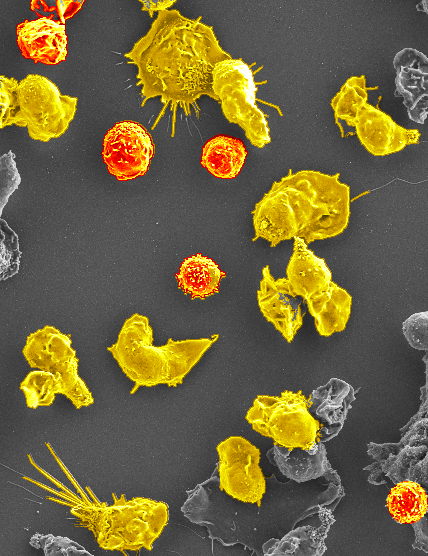New pathway to activate the warriors of our immune system

Failure to generate neutrophils in the bone marrow leads to devastating bacterial and fungal infections. Researchers from Karolinska Institutet have discovered a new pathway to elevate the number of tissue neutrophils by activating the cell cytoskeleton. The study is published in Journal of Clinical Investigation.
Neutrophils are key effector cells of the vertebrate immune system. They represent 50-70% of the white blood cells in human blood and their loss by disease or drug side-effect such as cancer treatment causes devastating bacterial and fungal infections. Their high turnover rate, their fine-tuned killing machinery, and their arsenal of toxic vesicles leave them particularly vulnerable to inborn genetic errors of the immune system.
“Our research group is interested to understand how failure to regulate the cell cytoskeleton in immune cells leads to severe immunodeficiency diseases” explains Lisa Westerberg, Associate Professor at the Department of Microbiology, Cell and Tumour Biology.
Upon an infection, neutrophils in the blood flow slow down and spread out on the endothelial cell walls in the blood vessel to squeeze through and move into the tissue. Tissue neutrophils rapidly migrate to the site of infection where they release toxic vesicles to kill microbes. By investigation of patient samples and animal models with mutation in the cytoskeletal regulator WASp, the KI researchers showed that decreased bone marrow output of neutrophils to the blood could be compensated in tissue neutrophils by increased WASp activity. “It was quite surprising to us that the activity of WASp could be further elevated in neutrophils leading to more rapid migration into tissues”, says lead author Dr Marton Keszei.
 The curative treatment for patients with neutropenia is life-long support with G-CSF to increase the bone marrow output of neutrophils. Side effects may include bone marrow failure associated with blood cancer. “Our study describes an example of atypical neutropenia in which low absolute neutrophil number in blood samples does not warrant life-long G-CSF support and may have implication for treatment of neutropenia patients of unknown cause,” says Lisa Westerberg.
The curative treatment for patients with neutropenia is life-long support with G-CSF to increase the bone marrow output of neutrophils. Side effects may include bone marrow failure associated with blood cancer. “Our study describes an example of atypical neutropenia in which low absolute neutrophil number in blood samples does not warrant life-long G-CSF support and may have implication for treatment of neutropenia patients of unknown cause,” says Lisa Westerberg.
The study was conducted in collaboration with Peter Vandenberghe at Leuven University Hospital, Scott Snapper from Harvard Medical School, and with contributions from several other groups. The research was supported by the Ragnar Söderberg foundation, the Swedish Research Council, the Swedish Cancer Society, the Swedish Childhood Cancer society, and EU Marie Curie among others
The Publication
Constitutive activation of WASp in X-linked neutropenia renders neutrophils hyperactive.
J. Clin. Invest. 2018 Aug;128(9):4115-4131
More information
